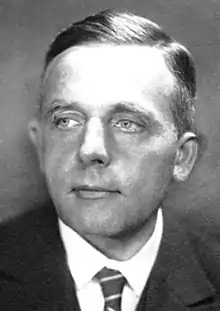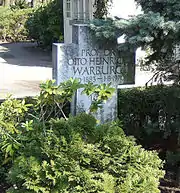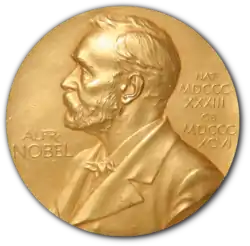Otto Heinrich Warburg
Otto Heinrich Warburg (/ˈvɑːrbɜːrɡ/; 8 October 1883 – 1 August 1970), son of physicist Emil Warburg, was a German physiologist, medical doctor, and Nobel laureate. He served as an officer in the elite Uhlan (cavalry regiment) during the First World War, and was awarded the Iron Cross (1st Class) for bravery.[2] He was the sole recipient of the Nobel Prize in Physiology or Medicine in 1931.[1] In total, he was nominated for the award 47 times over the course of his career.[3]
Otto Heinrich Warburg | |
|---|---|
 Otto Heinrich Warburg | |
| Born | 8 October 1883 |
| Died | 1 August 1970 (aged 86) |
| Nationality | German |
| Alma mater | University of Berlin University of Heidelberg |
| Known for | Pathogenesis of cancer Warburg effect (oncology) Warburg effect (plant physiology) |
| Awards | Iron Cross 1st class (1918) Nobel Prize in Physiology or Medicine (1931)[1] Pour le Mérite (Civil Class) (1952) Foreign Member of the Royal Society[2] |
| Scientific career | |
| Fields | Cell biology |
| Institutions | Kaiser Wilhelm Institute for Biology |
| Doctoral advisor | Emil Fischer Ludolf von Krehl |
Biography
Otto Heinrich Warburg was born in Freiburg im Breisgau in 1883, close to the Swiss border. Otto's mother was the daughter of a Protestant family of bankers and civil servants from Baden. His father, Emil Warburg, had converted to Protestantism as an adult, although Emil's parents were Orthodox Jews.[4] Emil was a member of the illustrious Warburg family of Altona, and had converted to Christianity reportedly after a disagreement with his Conservative Jewish parents. Emil was also president of the Physikalische Reichsanstalt, Wirklicher Geheimer Oberregierungsrat (True Senior Privy Counselor).
Otto Warburg studied chemistry under Emil Fischer, and earned his doctorate in chemistry in Berlin in 1906. He then studied under Ludolf von Krehl and earned the degree of doctor of medicine in Heidelberg in 1911.
Between 1908 and 1914, Warburg was affiliated with the Naples Marine Biological Station, (in Naples, Italy), where he conducted research. In later years, he would return for visits, and maintained a lifelong friendship with the family of the station's director, Anton Dohrn.
A lifelong equestrian, he served as an officer in the elite Uhlans (cavalry) on the front during the First World War, where he won the Iron Cross. Warburg later credited this experience with affording him invaluable insights into "real life" outside the confines of academia. Toward the end of the war, when the outcome was unmistakable, Albert Einstein, who had been a friend of Warburg's father Emil, wrote to Warburg at the behest of friends, asking him to leave the army and return to academia, since it would be a tragedy for the world to lose his talents. Einstein and Warburg later became friends, and Einstein's work in physics had a great influence on Warburg's biochemical research.
Scientific work and Nobel Prize
.jpg.webp)
While working at the Marine Biological Station, Warburg performed research on oxygen consumption in sea urchin eggs after fertilization and proved that upon fertilization the rate of respiration increases as much as sixfold. His experiments also proved iron is essential for the development of the larval stage.
In 1918, Warburg was appointed professor at the Kaiser Wilhelm Institute for Biology in Berlin-Dahlem (part of the Kaiser-Wilhelm-Gesellschaft). By 1931 he was named director of the Kaiser Wilhelm Institute for Cell Physiology, which was founded the previous year by a donation of the Rockefeller Foundation to the Kaiser Wilhelm Gesellschaft (since renamed the Max Planck Society).
Warburg investigated the metabolism of tumors and the respiration of cells, particularly cancer cells, and in 1931 was awarded the Nobel Prize in Physiology for his "discovery of the nature and mode of action of the respiratory enzyme".[1] In particular, he discovered that animal tumors produce significant quantities of lactic acid.[5] The award came after receiving 46 nominations over a period of nine years beginning in 1923, 13 of which were submitted in 1931, the year he won the prize.[3]
Nobel Laureate George Wald, having completed his Ph.D. in zoology at Columbia University, received an award from the U.S. National Research Council to study with Warburg. During his time with Warburg, 1932–1933, Wald discovered vitamin A in the retina.
Survival under the Nazis
When the Nazis came to power, people of Jewish descent were forced from their professional positions, although the Nazis made exceptions. Warburg had a Protestant mother and a father with Jewish heritage (who had converted to Protestantism). Although banned from teaching, he was allowed to carry on his research.[6]
According to the Reichsbürgergesetz from 1935 (cf. Nuremberg Laws) Warburg was considered by the Nazis a half-Jew (Halbjude) resp. Mischling and in September 1942 he issued an official request for equal status ("Gleichstellung") with Germans, which was granted.[7]
In 1941, Warburg lost his post briefly when he made critical remarks about the regime, but a few weeks later a personal order from Hitler's Chancellery ordered him to resume work on his cancer research. Göring also arranged for him to be classified as one-quarter Jewish.[6]
It is believed that Warburg was so totally dedicated to his work that he was prepared not only to stay in Germany but also to accept the Nazi treatment of his Jewish colleagues and his Jewish relatives.[8] This was despite his having received an offer from the Rockefeller Foundation to continue to fund his work if he emigrated. After the end of the Second World War, he made inquiries about moving to the United States of America, but his approach then was turned down.
In 1943 Warburg relocated his laboratory to the village of Liebenburg on the outskirts of Berlin to avoid ongoing air attacks.
Nomination for a second Nobel Prize
.jpg.webp)
In 1944, Warburg was nominated for a second Nobel Prize in Physiology by Albert Szent-Györgyi, for his work on nicotinamide, the mechanism and enzymes involved in fermentation, and the discovery of flavin (in yellow enzymes).[9][10] Some sources report that he was selected to receive the award that year, but was prevented from receiving it by Adolf Hitler's regime, which had issued a decree in 1937 that forbade Germans from accepting Nobel Prizes.[11][12] According to the Nobel Foundation, this rumor is not true; although he was considered a worthy candidate, he was not selected for the prize at that time.[9]
Three scientists who worked in Warburg's lab, including Sir Hans Adolf Krebs, went on to win the Nobel Prize in future years. Among other discoveries, Krebs is credited with the identification of the citric acid cycle (or Szentgyörgyi-Krebs cycle).
Warburg's combined work in plant physiology, cell metabolism, and oncology made him an integral figure in the later development of systems biology.[13] He worked with Dean Burk on the quantum yield of photosynthesis. He ended up in a long-standing feud with his former student Robert Emerson about the minimum photon requirement for photosynthesis. Warburg ended up on the losing side of the argument and could not accept 10 or 12 instead of 4 or 5 photons (as detailed by Nickelsen and Govindjee in their account: "The maximum quantum yield controversy. Otto Warburg and the ‘Midwest-Gang’ Kärin Nickelsen and Govindjee. 2011. Bern Studies in the History and Philosophy of Science."
Cancer hypothesis
Warburg hypothesized that cancer growth is caused by tumor cells generating energy (as, e.g., adenosine triphosphate/ATP) mainly by anaerobic breakdown of glucose (known as fermentation, or anaerobic respiration). This is in contrast to healthy cells, which mainly generate energy from oxidative breakdown of pyruvate. Pyruvate is an end product of glycolysis and is oxidized within the mitochondria. Hence, according to Warburg, cancer should be interpreted as a mitochondrial dysfunction.
Cancer, above all other diseases, has countless secondary causes. But, even for cancer, there is only one prime cause. Summarized in a few words, the prime cause of cancer is the replacement of the respiration of oxygen in normal body cells by a fermentation of sugar.
— Otto H. Warburg, [14]
Warburg continued to develop the hypothesis experimentally and gave several prominent lectures outlining the theory and the data.[15]
Today, mutations in oncogenes and tumor suppressor genes are thought to be responsible for malignant transformation, and the metabolic changes Warburg thought of as causative are now considered to be a result of these mutations.[16]
However, a recent reevaluation of the data from nuclear/cytoplasm transfer experiments, where nuclei from cancer cells are placed in normal cytoplasm and where nuclei from normal cells are placed in cancer cytoplasm, more strongly supports Warburg's original theory than the somatic mutation theory for the origin of malignant transformation and cancer.[17][18]
Later years

Otto Warburg edited and had much of his original work published in The Metabolism of Tumours (tr. 1931) and wrote New Methods of Cell Physiology (1962). An unabashed anglophile, Otto Warburg was thrilled when Oxford University awarded him an honorary doctorate. He was awarded the Order Pour le Mérite in 1952 and was known to tell other universities not to bother with honorary doctorates. He would ask officials to mail him medals he had been awarded so as to avoid a ceremony that would separate him from his beloved laboratory.
When frustrated by the lack of acceptance of his ideas, Warburg was known to quote an aphorism he attributed to Max Planck: "Science advances one funeral at a time".[19][20]
Seemingly utterly convinced of the accuracy of his conclusions, Warburg expressed dismay at the "continual discovery of cancer agents and cancer viruses" that he expected to "hinder necessary preventive measures and thereby become responsible for cancer cases".[15]
When Josef Issels was tried and convicted for promoting the Issels treatment, an ineffective regimen claimed to treat cancer, Warburg offered to testify on Issels' behalf at his appeal to the German Supreme Court. All of Issels' convictions were overturned.[21]
Warburg never married and resided in the Kaiser Wilhelm Institute with his faithful companion, Jacob Heiss, a personal friend and the secretary and manager of the Kaiser Wilhelm Institute. Warburg pursued his research until the age of 86.
In 1968, he suffered a broken femur. This was complicated by deep vein thrombosis. He died in 1970 from pulmonary embolism and was buried in a Christian cemetery.[22]
The Otto Warburg Medal
The Otto Warburg Medal is intended to commemorate Warburg's outstanding achievements. It has been awarded by the German Society for Biochemistry and Molecular Biology (Gesellschaft für Biochemie und Molekularbiologie) since 1963. The prize honors and encourages pioneering achievements in fundamental biochemical and molecular biological research. The Otto Warburg Medal is regarded as the highest award in Germany for biochemists and molecular biologists. It has been endowed with prize money, sponsored by the publishing company Elsevier/BBA.[23]
Bibliography
- Über die Rolle des Eisens in der Atmung des Seeigeleis nebst Bemerkungen über einige durch Eisen beschleunigte Oxydationen m. Abb. (Sitzungsber. Heidelberger Akad. Wiss. math.-nat. Kl B Heidelberg, 1911) (Trans: On the rôle of Iron in the Breathing of the Sea Urchin Egg and Comments about some Oxidations accelerated by Iron. Proceedings of the Heidelberg Academy of Sciences Heidelberg 1911.)
- Schwermetalle als Wirkungsgruppe von Fermenten (Berlin, 1946.) (Trans: Heavy metal prosthetic groups and enzyme action)
- Ideen zur Fermentchemie der Tumoren (Abh. der Deutschen Akad. der Wissenschaften zu Berlin. Math-naturwissenschaft. Kl 1947, Berlin 1947) (Trans: Theses on the enzymatic chemistry of Tumors, Proceedings of the German Academy of Sciences in Berlin, mathematical-scientific ?, Berlin 1947)
- Wasserstoffübertragende Fermente (Berlin, Saenger 1948) (Trans: Hydrogen-transferring Enzymes)
- Weiterentwicklung der zellphysiologischen Methoden: angewandt auf Krebs, Photosynthese und Wirkungsweise der Röntgenstrahlung: Arbeiten aus den Jahren 1945-1961, (Thieme, Stuttgart 1962) (Trans: Further Developments of Methods in Cellular Physiology applied to Cancer, Photosynthesis and the Effects of X-ray Radiation) Texts in German and English
- Nobel Lectures, Physiology or Medicine 1922-1941, Amsterdam: Elsevier Publishing Company, 1965
- Chernow, Ron (1993), The Warburgs: The Twentieth-Century Odyssey of a Remarkable Jewish Family, New York, NY: Random House, ISBN 978-0-679-41823-8
- Govindjee, Kärin Nickelsen (2011). The maximum quantum yield controversy. Otto Warburg and the 'Midwest-Gang' (Paperback). Institut Für Philosophie. ISBN 978-3-95234-219-0.
- Issels MD, Josef (1981), Mein Kampf gegen den Krebs: Erinnerungen eines Arztes, C. Bertelsmann, ISBN 978-3-570-04736-1
- Krebs, Hans Adolf (1981), Otto Warburg: Cell Physiologist, Biochemist, and Eccentric, Oxford University Press, ISBN 978-0-19-858171-0
- Liljestrand, Göran; Bernhard, Carl Gustaf (1972), "The Prize in Physiology or Medicine", in Nobel Foundation; Odelberg, W. (Coordinating Ed.) (eds.), Nobel: The Man and His Prizes (3rd ed.), New York, NY: American Elsevier Publishing Company, Inc, pp. 139–278, ISBN 978-0-444-00117-7
- Medawar, Jean; Pyke, David (2012). Hitler's Gift: The True Story of the Scientists Expelled by the Nazi Regime (Paperback). New York: Arcade Publishing. ISBN 978-1-61145-709-4.
- Werner, Petra (1991), Ein Genie Irrt Seltener, Berlin: Akademie Verlag, ISBN 978-3-05-501282-2
- Werner, Petra (1988), Otto Warburg : Von der Zellphysiologie zur Krebsforschung : Biografie, Verlag Neues Leben, ISBN 978-3-355-00789-4
References
- NobelPrize.org, The Nobel Prize in Physiology or Medicine 1931 accessed April 20, 2007
- Krebs, H. A. (1972). "Otto Heinrich Warburg 1883-1970". Biographical Memoirs of Fellows of the Royal Society. 18: 628–699. doi:10.1098/rsbm.1972.0023. PMID 11615754.
- "Nomination Database - Physiology or Medicine". Nobelprize.org. Retrieved 2011-06-04.
- Weisz, GM (2015). "Dr. Otto heinrich warburg-survivor of ethical storms". Rambam Maimonides Med J. 6 (1): e0008. doi:10.5041/RMMJ.10183. PMC 4327324. PMID 25717390.
- Parks, Scott K.; Mueller-Klieser, Wolfgang; Pouysségur, Jacques (2020). "Lactate and Acidity in the Cancer Microenvironment". Annual Review of Cancer Biology. 4: 141–158. doi:10.1146/annurev-cancerbio-030419-033556.
- Medawar & Pyke. Page 184.
- Reinhard Rürup, unter Mitwirkung von Michael Schüring: Schicksale und Karrieren: Gedenkbuch für die von den Nationalsozialisten aus der Kaiser Wilhelm Gesellschaft vertriebenen Forscherinnen und Forscher. Wallstein 2008, S. 83f. ISBN 978-3-89244-797-9
- Medawar & Pyke. Page 185.
- Liljestrand & Bernhard 1972, "The Prize in Physiology or Medicine", p. 210
- "Nomination Database - Physiology or Medicine". Nobelprize.org. 1944. Retrieved 2011-06-04.
- "Otto Warburg". Encyclopædia Britannica Online. 2007. Archived from the original on 2007-12-19. Retrieved 2007-11-12.
- Chernow 539-541.
- A Systems Approach to Biology, by Jeremy Gunawardena, Department of Systems Biology, Harvard Medical School, lecture 1, September 2011 retrieved 5 May 2012
- Brand, R. A. (2010). "Biographical Sketch: Otto Heinrich Warburg, PhD, MD". Clinical Orthopaedics and Related Research. 468 (11): 2831–2832. doi:10.1007/s11999-010-1533-z. PMC 2947689. PMID 20737302.
- Warburg, O. (1956). "On the Origin of Cancer Cells". Science. 123 (3191): 309–314. Bibcode:1956Sci...123..309W. doi:10.1126/science.123.3191.309. PMID 13298683.
- Bertram, JS (December 2000). "The molecular biology of cancer". Molecular Aspects of Medicine. 21 (6): 167–223. doi:10.1016/s0098-2997(00)00007-8. PMID 11173079.
- Seyfried, Thomas N.; Flores, Roberto E.; Poff, Angela M.; D’Agostino, Dominic P. (March 2014). "Cancer as a metabolic disease: implications for novel therapeutics". Carcinogenesis. 35 (3): 515–527. doi:10.1093/carcin/bgt480. ISSN 0143-3334. PMC 3941741. PMID 24343361.
- Seyfried, Thomas T.N. (July 2015). "Cancer as a mitochondrial metabolic disease". Frontiers in Cell and Developmental Biology. 3: 43. doi:10.3389/fcell.2015.00043. PMC 4493566. PMID 26217661 – via PMC.
- Max Planck > Quotes > Quotable Quote. goodreads.com
- van Wijk, Roeland (2014). Light in Shaping Life: Biophotons in Biology and Medicine. p. 86. ISBN 978-90-818843-2-7.
- Issels.
- Weisz, G. M. (2015). "suffered a broken femur, complicated by deep vein thrombosis, and in 1970, Otto Heinrich Warburg died from a pulmonary embolism; from Google (otto warburg died) result 3". Rambam Maimonides Medical Journal. 6 (1): e0008. doi:10.5041/RMMJ.10183. PMC 4327324. PMID 25717390.
- "The Otto Warburg Medal". elsevier.com. Retrieved 2014-07-03.
